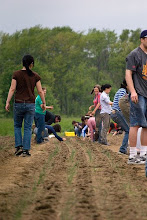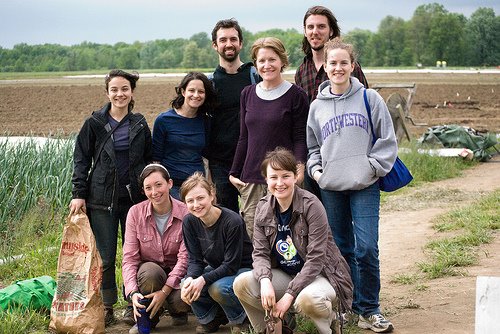This week our fruit variety supply is a little short. We know that you will be getting blueberries but cherry and black raspberry season have come to an end and the plums and apricots are ‘teasing’ us but not quite ready. We are hoping to be able to pick just enough apricots for you tomorrow morning. Peaches are just around the corner and they look really good right now.
Because we cannot send you three kinds of fruit this week, we are sending you some of our “Orchard Blossom” honey. We have 10 bee hives in our orchards year round. Every spring we have about 1200 kindergarten children visit our farm to learn about the honey bee and its importance in pollination. All of our fruit (and many vegetables) start out as a fruit blossom. These must be pollinated and the honey bee is the best at getting this done. I explain to the children if not for honey bees, there would be no apples, pears, strawberries, zucchini, melons, … I then talk about a crop called cotton that is also pollinated by bees and I explain to the children that my clothes (even my underwear) is made from cotton and if not for the honey bees we would all be hungry and have no clothes on. This, of course, makes them giggle but also helps them understand how important the honey bee is to us. A bee hive is an amazing thing. In the summer months one hive may have 60,000 bees. There is one queen bee, several hundred
drones (male bees), and all the rest are female worker bees. Every bee has a job to do in the hive. A queen may live up to 5 years and may lay 1200 eggs/day. Drones are there only for fertilizing the queen. They have no stinger and cannot feed themselves. They pretty much just sit around the hive and drink nectar. But, in the winter, drones are forced out of the hive. The ‘worker’ bees are female and they do all the work; house cleaning, nurse bees, house builder bees, fan bees, scout bees, guard bees, and finally collector bees. One honey bee lives about 6 weeks in the summer and produces about ½ teaspoon honey in that life span. Honey bees make honey to survive through winter months. They are very industrious and make way more
than they need so we ‘STEAL’ that extra honey. We average about 60 pounds of honey/hive.
Honey can taste different and is dependent upon what the bee was foraging. The lighter the honey, the lighter the flavor. We call ours orchard blossom because the bees gather from whatever is in blossom; apples, peaches, zucchini, wildflowers, etc. We hope you enjoy the work of our honey bees in their pollinated fruit and this week in their honey.
Last year we did not pick ONE apricot. They bloom in late April and often are frozen out by a spring frost. This year there are TOO many. When they were the size of grapes, we had to ‘thin’ the fruit so it was about 3-5” apart. (We do this with peaches too). If there is
too much fruit on a tree, the energy of the tree is spread out over all that fruit and the quality is not as good as if there is less fruit. This year the birds seem to be really enjoying the apricots.
We have a special machine set up in the orchard that sends out bird distress calls and seems to be helping keep the birds away. We hope you like the apricots as much as the birds do.
Thank you, Doug and Talea Fincke and everyone at Montgomery Place Orchards
Tuesday, July 21, 2009
Subscribe to:
Post Comments (Atom)




No comments:
Post a Comment